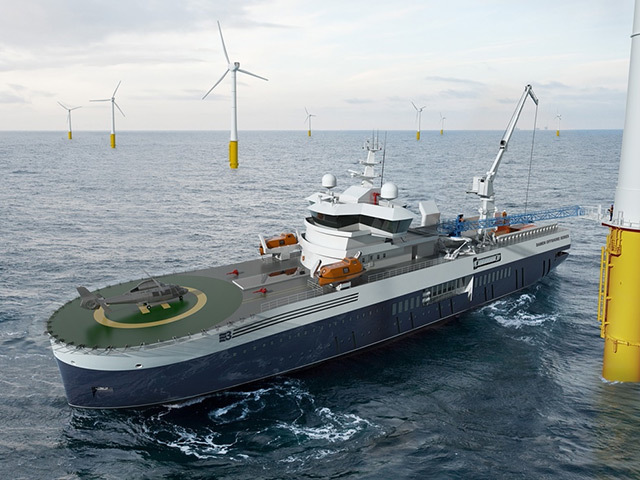
Damen Shipyards has unveiled a completely new windfarm service vessel (WSV) to support and accommodate turbine maintenance crews at sea and allow them to “walk-to-work”.
After industry-wide consultation, the Dutch shipyard decided to design the vessel from first principles to provide on-site w ork facilities and accommodation for 45 maintenance personnel plus 15 crew for campaigns of up to one month.
At last, a vessel with sufficient muscle and stature is being offered to windfarm developers which have, for too long, tried to rely on much smaller craft in the 20-30m range to transfer personnel to and from turbines and associated infrastructure.
Damen has already carved out a significant presence in the windfarm support vessel market, following the launch of its radical 26m FCS 2610 Twin Axe, a high-speed maintenance support catamaran.
Designed for the transfer of 12 service personnel, 21 of these purpose-built craft have been delivered and four more have been sold, all in 25 months. Damen is building more for stock to shorten delivery times.
Explaining the reasons for the new design Peter Robert, the company’s business development manager for offshore wind, said: “There is a growing trend for wind turbines to be located further from shore.
“At distances greater than 30 nautical miles (47km), maintenance crew transfer from shore within one day becomes both impractical and costly.
“When we sought market views on a larger support vessel, potential customers set us an 80% availability target for maintenance crew transfer in wave heights of up to 3m.
“At the same time, the vessel needed exceptional levels of comfort because turbine engineers often have a land-based background and staff retention is an issue.”
In other words, Damen is applying offshore oil and gas industry standards to its large new renewables service vessel offering.
The result is a study lookingmonohull with bridge and accommodation located amidships for seakeeping comfort.
With a 90m length overall and a beam of 20m, the diesel-electric Damen WSV will feature 500sq.m of deck space, a heli-deck and a motion and heave compensating crane. Its shallow 4.6m draft optimises comfort, while also conferring significant power savings.
Designed to drop seven maintenance crews within three hours, the vessel will remain within range to provide support and emergency assistance through the working day before pick up.
The dynamically positioned (DP2) WSV will include a telescopic, motion-compensated gangway. This will allow each three-man maintenance team to walk quickly and safely between vessel and turbine.
Special attention has been paid to interiors and onboard service space lay-out. Public spaces have been mapped for efficient work-flows and storage, while 60 single occupancy cabins, a fitness centre and internet/movie services will benefit life at sea.
“Judging by initial feedback, this vessel will make a significant impact on this specialised market,” said Robert. “In addition, it is also attracting interest from the oil and gas sector.”
The latter’s interest is to be expected as operators are keen to find viable vessel-based alternatives to helicopter transfers following the spate of Super Puma incidents in the Northern North Sea.
“Walk-to-work” has become a buzz phrase and various personnel transfer systems have been developed to enable workers to step from a vessel to turbines or oil and gas installations.
Indeed, Norwegian company Island Offshore has just entered into a contract with an undisclosed major oil company covering the charter of the purpose built, state-of-the-art “walk-to-work”, maintenance, subsea and support vessel Island Crown.
The contract is a seasonal charter and the main duty for the vessel will be to provide accommodation and walk-to-work duties by means of a fully integrated gangway fitted on the vessel.
The duration of the contract is five months firm, and covers the seasonal charter of the vessel in 2014 and 2015, with further options for the 2016 and 2017 season.
Recommended for you
